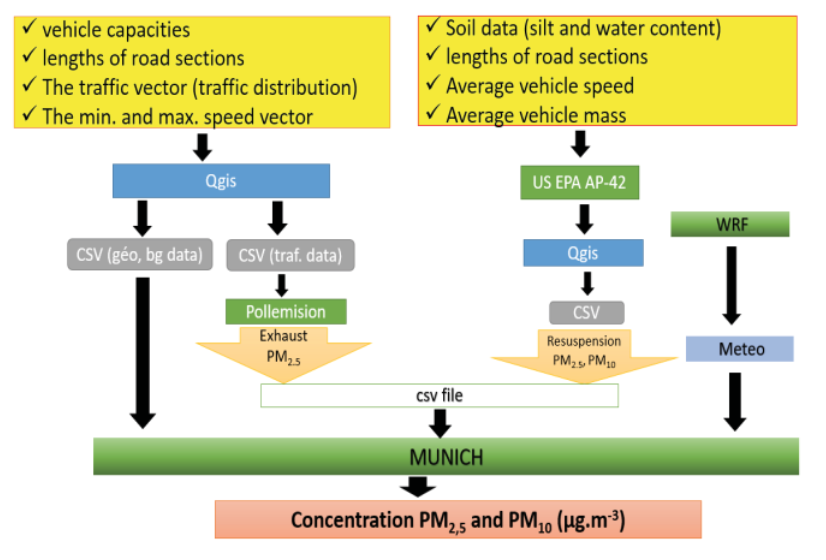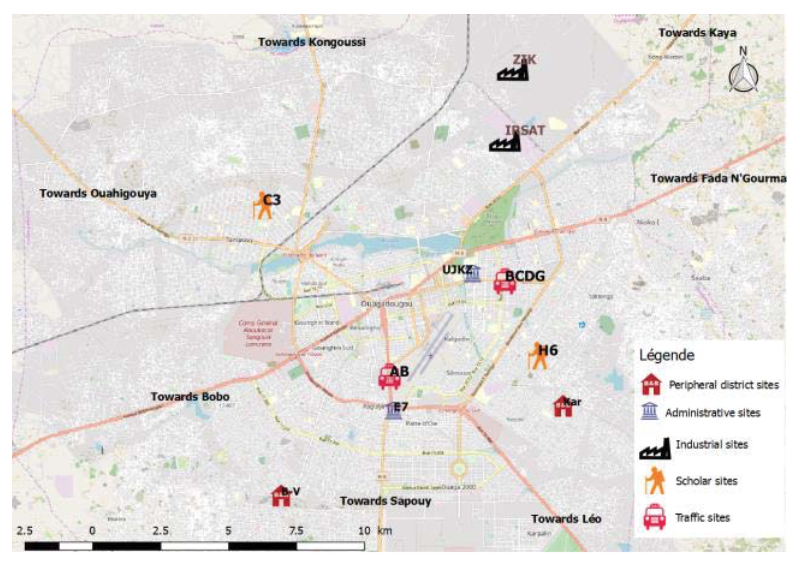Assessing and modeling particulate pollution in the city of Ouagadougou (Burkina Faso)
- Post by: SOAPHYS-KZ
- 10 mars 2021
- Comments off


http://dx.doi.org/10.4641/jpsoaphys.2020.01.14
J. P. Soaphys, Vol 2, N°1 (2020) C20A10; 14 Fevrier 2021
Pages : C20A14-1 à C20A14-6
Information sur les auteurs
Ouarma Issoufou*,
Nana Bernard,
Haro Kayaba,
Koulidiati Jean,
Béré Antoine
Affiliation
1Laboratoire de Physique et de Chimie de l’Environnement, Université Joseph KI-ZERBO, Ouagadougou, Burkina Faso
2Institut Des Sciences, Ouagadougou, Burkina Faso
3 Institut de Recherche en Sciences Appliquées et Technologie, Centre National de la Recherche Scientifique et
Technologique, Ouagadougou, Burkina Faso
*To whom correspondances should be addressed. E-mail: fabricebado726@gmail.com
Abstract
In the present work, the pollution levels of airborne particles in the city of Ouagadougou have been assessed through two campaigns of in situ measurements of PM2.5 and PM10 concentrations. These measures were performed using a portable device (AEROCET 531S) on roadside sites and on sites located in administrative services, secondary schools and outlying districts. Since in situ measurements don’t give any indication of the pollution that could be due to a new source (industrial plant, road, etc.) and how it is dispersed spatially and temporally, thus pollutant emissions from road traffic and the dispersion of these pollutants are obtained by a modelling chain that couples COPERT IV emission model under Pollemission code with MUNICH dispersion model. As results, the average 24-hour concentrations are 87±16 and 951±266 μg/m3 for the PM2.5 and PM10, respectively, in 2018 dry season. They are 29±5 and 158±43 μg/m, respectively, in 2018 rainy season and, 22±9 and187±67 μg/m^3 in 2019 rainy season, respectively. These results show that independently of the season (dry or rainy), the PM10 concentrations are high and exceed the World Health Organization Air Quality Guidelines (WHOAQG) and European 24-hour threshold value of 50 μg/m . Concerning the PM2.5 concentrations in dry season, they are high and exceed the WHO AQG and European 24-hour threshold value of 25 μg/m . The results obtained concerning the modeling of the dispersion of PM air pollution due to road traffic in the city of Ouagadougou are partially satisfactory. The modeled maximum values of the exhaust emission factors are very high while the modeled concentrations are underestimated compared to the measured concentrations. The estimated emission factors range between 0 and 400 g/km/h and between 0 and 303 g/km/h for exhaust PM2.5 and resuspension PM2.5, respectively. They vary between 0 and 2 997 g/km/h for resuspension PM10. Concerning the modelled concentrations, they are between 0 and 238 μg/m3 for PM2.5 and between 0 and 2 072 μg/m3 for PM10. These results can be improved with updated traffic and road characterization data.
Keywords : Particulate pollution ; PM2.5 ; PM10 ; AEROCET ; MUNICH ; COPERT IV, US EPA AP 42, Modeling
| Abdallah, C., C. Afif, S. Sauvage, A. Borbon, T. Salameh, A. Kfoury, T. Leonardis, et al., (2020). | ||||
| Determination of Gaseous and Particulate Emission Factors from Road Transport in a Middle Eastern Capital. Transportation Research Part D: Transport and Environment 83: 102361. https://doi.org/10.1016/j.trd.2020.102361 https://doi.org/10.1016/j.trd.2020.102361 |
||||
| Airparif. (2008). Synthèse des connaissances sur les | ||||
| particules en suspension dans l’air et des travaux d’Airparif sur ces polluants. | ||||
| Chen, R. et Mallet, V. (2016). Pollemission software computing traffic emissions of atmospheric pollutants with COPERT-IV formulations. https://github.com/pollemission | ||||
| Gkatzoflias, D. et al. (2008). Copert 4′, Mechanical Engineering. (December 2015). | ||||
| Kim, Y. et al. (2018). Multi-scale modeling of urban air pollution: Development and application of a Street-in- Grid model (v1.0) by coupling MUNICH (v1.0) and Polair3D (v1.8.1). Geoscientific Model Development. Copernicus GmbH. 11(2), pp. 611-629. https://doi.org/10.5194/gmd-11-611-2018 https://doi.org/10.5194/gmd-11-611-2018 |
||||
| Lindén, J. et al. (2012). Intra-urban air pollution in a rapidly growing Sahelian city. Environment International. 40(1), pp. 51-62. https://doi.org/10.1016/j.envint.2011.11.005 https://doi.org/10.1016/j.envint.2011.11.005 |
||||
| Loomis, D. et al. (2013). The carcinogenicity of outdoor air pollution. The Lancet Oncology. 14(13), pp. 1262- 1263. https://doi.org/10.1016/S1470-2045(13)70487-X. https://doi.org/10.1016/S1470-2045(13)70487-X |
||||
| MEDDTL. (2010). Ministère de l’écologie, du développement durable, des transports et du logement. Opération SERRES – État de l’art des mesures de pollution et de trafic par le capteur laser. Rapport 01. CETE de l’Ouest/Laboratoire Régional des Ponts et Chaussées d’Angers (France). | ||||
| Nana, B., Sanogo, O, Savadogo, P. W, Daho, T., Bouda, M. and Koulidiati, J. (2012). Air Quality Study in Urban Centers: Case Study of Ouagadougou, Burkina Faso. FUTY Journal of the Environment. 7(1), pp. 1- 18. http://dx.doi.org/10.4314/fje.v7i1.1 https://doi.org/10.4314/fje.v7i1.1 |
||||
| Ouarma Issoufou. (2012). Étude des propriétés mécaniques des matériaux de construction : cas des blocs en terre comprimés obtenus avec de la terre latéritique au ciment et de la décoction de néré. Mémoire de D.E.A, UFR-SEA, Université de Ouagadougou (Burkina Faso) | ||||
| Ouarma, I., Nana, B., Haro, K., Béré, A and Koulidiati, J. (2020). Assessment of pollution levels of suspended particulate matter on an hourly and a daily time scale in West African cities: case study of Ouagadougou (Burkina Faso). Journal of Geoscience and Environmental Protection. 8(11), pp 119-138. https://doi.org/10.4236/gep.2020.811007 https://doi.org/10.4236/gep.2020.811007 |
||||
| Raaschou-Nielsen, O. et al. (2013). Air pollution and lung cancer incidence in 17 European cohorts: Prospective analyses from the European Study of Cohorts for Air Pollution Effects (ESCAPE). The Lancet Oncology. 14(9), pp. 813-822. https://doi.org/10.1016/S1470-2045(13)70279-1. https://doi.org/10.1016/S1470-2045(13)70279-1 |
||||
| Somda D. D. (2018). Inventaire d’émissions de polluants atmosphériques issus du trafic routier à Ouagadougou (Burkina Faso). Mémoire de Master, IGEDD, Université Ouaga I Pr Joseph KI-ZERBO (Burkina Faso) | ||||
| Tsai, M. Y. et al. (2015). Spatial variation of PM elemental composition between and within 20 European study areas – Results of the ESCAPE project. Environment International. 84, pp. 181-192. https://doi.org/10.1016/j.envint.2015.04.015 https://doi.org/10.1016/j.envint.2015.04.015 |
||||
| US EPA. (2011). Emission Factor Documentation for AP-42. Section 13.2.1. U.S. Environmental protection Agency. https://www.epa.gov/air-emissions-factors- and-quantification/ap-42-compilation-air-emissions- factors | ||||



